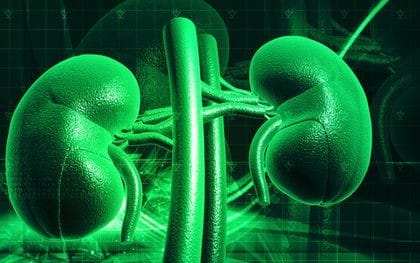Adrenal Gland Disorders
Secretes hormones
| Download this episode | Most people probably don’t know where their adrenal glands are located, much less what kind of role they play in their daily functions. Located on top of both kidneys, the adrenal glands are triangular-shaped and measure three inches in length. The inner part of the glands secretes hormones such as adrenaline that affect blood pressure, heart rate and sweating. The outer part secretes many different hormones that control the use of fats, proteins and carbohydrates in the body. It also secretes male sex hormones as well as hormones that control blood pressure and the levels of salt and potassium in the body. If the adrenal glands are not functioning correctly the cause could be outside the gland. For instance, the hypothalamus, a part of the brain, or pituitary glands could fail to produce hormones that control the adrenal glands. A problem inside the adrenal gland could be caused by some kind of disease or infection in or around the gland. | Cushing’s syndrome refers to a complex set of symptoms and physical abnormalities caused by an excess of the hormone cortisol in the body. Most prevalent in adults between the ages of 20 and 50, it occurs when too much cortisol is produced in the adrenal glands. It can also be caused by excessive or prolonged use of steroids. Prolonged natural production of cortisol can be linked to various sources, the most common of which is a tumor of the pituitary gland. Cushing’s sufferers can be identified by their characteristic round, full faces and humps of fat collected between the shoulders. Once the syndrome has been diagnosed, imaging and other tests may be ordered to identify the exact cause. If the excess cortisol is caused by medication, a change in dosages or a different medication may be recommended to correct the problem. If the Cushing’s syndrome is caused by the body making too much cortisol, treatments may include oral medication, surgery, radiation, or a combination of these. | Congenital adrenal hyperplasia, also known as CAH, is a genetic disorder of the adrenal glands. Normally, the adrenal glands help keep the body in balance by making the right amounts of hormones, such as cortisol, aldosterone, and androgens. In people with CAH, the body doesn’t make enough of the hormone cortisol. Their adrenal glands may also not make aldosterone and, instead, make too much androgen. CAH is passed down from parents to their children, the most common autosomal recessive genetic disorder in humans. People with congenital adrenal hyperplasia tend to be shorter than their parents, to display early signs of puberty as a child and, in the case of women, to have excessive facial hair and irregular periods. Testing for the severe form of CAH is now part of a routine newborn screening done in most states. Treating the disorder involves taking medication to replace the hormones the body is not making. | The adrenal gland disorder known as hyperaldosteronism is defined by the body’s overproduction of aldosterone, a hormone that controls sodium and potassium levels in the blood. The overproduction of aldosterone leads to hypertension. The condition occurs mostly in women between the ages 30 and 50, and can occur from an abnormal growth in both adrenal glands or from a benign tumor on one of the adrenal glands. Besides hypertension, a patient may experience reduced blood pressure when they stand after lying down. Constipation, excessive thirst and personality changes are also possible symptoms. When hyperaldosteronism is suspected, blood and urine tests may be conducted to check for a high level of aldosterone and low levels of potassium. Removal of the tumor by laparoscopic surgery is a common treatment, although some patients may require medication to treat persistent high blood pressure. | Addison’s disease occurs when the adrenal glands produce too little of the hormone cortisol and often insufficient levels of aldosterone as well. Also known as adrenal insufficiency, the disease occurs in all age groups and can be life threatening. Addison’s can occur when the outer layer of the adrenal gland is damaged, usually by an autoimmune disease, or when another condition causes the gland to fail to produce enough hormones. Some of the symptoms, such as muscle weakness and sensitivity to cold, can develop over several months. Others, such as pain in the abdomen or low blood pressure, can appear suddenly and can be fatal if not treated. Treating Addison’s disease usually involves taking corticosteroids to replace the hormones your body is not making. An androgen replacement may also be recommended. Some women who have Addison’s disease find that taking an androgen replacement improves their mood and sex drive.
Transcript
Cushing’s syndrome
Transcript
Congenital adrenal hyperplasia
Transcript
Hyperaldosteronism
Transcript
Addison’s disease
Transcript
